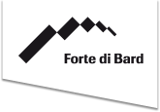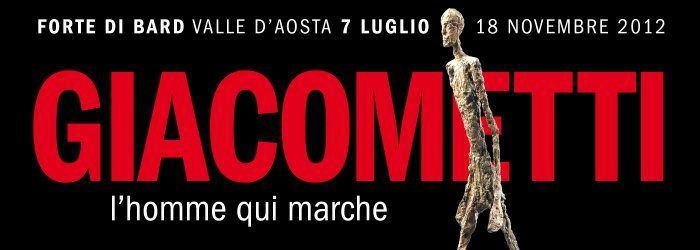This prestigious exhibition project is dedicated to one of the major artists of the 20th Century – the Swiss Italian Alberto Giacometti who, better than anyone, grasped the doubts, uncertainties and anguish of the last century – and stems from a venture between the Fortress of Bard and the Aimé et Marguerite Maeght Foundation of Saint-Paul-de-Vence and, in particular, the close relationship with Adrien Maeght and his daughter Isabelle Maeght, following the success of Poème (the exhibition dedicated to Joan Miró).
The exhibition The walking man, named after the masterpiece on which the entire display is centred, features over 120 works including sculptures, oils, drawings, original lithographs, etchings in addition to a few, very delicate and tiny plaster models, across an itinerary predominantly focused on the artist’s ‘mature’ works that were exclusively dedicated to man and the inner life. The exhibition is open to 7 july to 18 november 2012.
Curated by Isabelle Maeght and Gabriele Accornero, the exhibition chronicles Giacometti’s rich productivity through pieces taken from the Maeght Foundation and the Maeght family’s private collections. A sculptor, painter and highly skilled draughtsman, Giacometti was close to the artistic avant-guarde movements, in particular surrealism, and developed an entirely personal path of existentialist thought. The subjects of his sculptures – half and full torso’s, individual figures or compositions with multiple figures standing still or in motion – are inert, rigidly frontal figures with jagged outlines throughout, thus hinting but at the same time also dissipating their presence.
The show covers the artist’s entire path, and includes a number of works from the 20’s, such as Diego à l’Atlas and Arbres, works from the beginning of the 30’s, such as Le Cube and L’Objet Invisible shown for the first time with their preparatory sketches, Les pieds dans le plat, a drawing from his surrealist period, and the double-faced L’Objet invisible – a unique piece of work which he offered to Adrien Maeght -, his torso’s, amongst which Grande tête de Diego and Buste de Diego and the undisputed masterpieces Femme Debout II, the nine versions of Femme de Venise, which he prepared for the Venice Biennale, bronze groups of figures, such as Groupe de trois hommes and La Place: trois figures et une tête, the extraordinary Le Chien and the series on Femme debout and Figurine. Also on show are his delicate Homme qui marche, Femme and Tête, projects created for the Chase Manhattan Bank square in New York and subsequently cast for the courtyard dedicated to Giacometti at the Maeght Foundation in Saint-Paul-de-Vence. Amongst his paintings are La Maison d’en face, Portrait de Marguerite Maeght (his most important painting) and Nature morte aux pommes. Also on display are many of his drawings, notably the eight drawings for Projet pour un livre, Nu debout, Diego, Portrait d’homme and Nu. His remarkable original lithographies comprise Homme debout and Atelier I, both versions of his Objet inquiétant, Chien et Chat. Etchings, such as L’Atelier aux deux seaux, and both versions of Bouquet and Nu de face are also on show. Last, but not least, his Femme debout avec bouquet de fleurs and Femme debout bras le long du corps, are exceptionally refined examples of his plaster work.
The exhibition is named after the work Homme qui marche II (the Walking Man II), a bronze sculpture which fetched a sale price of over 104 million Usd, setting a world record for a work of art that isn’t a painting, at Sotheby’s of London on 3 February 2010. This formal rendering of the human condition into a diaphanous, lonely and hesitant figure about to take a step, is a universally recognised symbol, and represents the enormous aesthetic heritage left by Giacometti, a powerful witness of his times. In the words of Adrien Maeght “ I consider The Walking Man as one of the major works of the 20th Century. For me not only does it encompass the history of sculpture, but also serves as precursor to the 21st Century, the one when man returns to the core of civilisation”.



